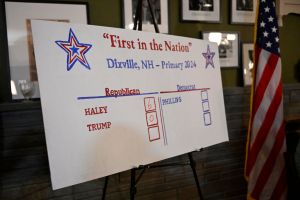The most alarming aspect of living in America is the recurring sensation that no one is in charge. This is much more disconcerting than recognizing that the people in charge are incompetent and corrupt: that is merely a sorry fact of everyday life. Three times in two decades the world’s most powerful state has failed its people: on 9/11, in the crash of 2007-8 and in the COVID-19 pandemic. Once is unfortunate, twice is carelessness, thrice is recklessness, and after that you’re on your own. My basement now resembles a nuclear bunker: food, water, medical supplies, a gym, a lifetime supply of lavatory paper. I live in an affluent, blue-state suburb with hardly any crime, but at night I wonder whether it’s time to go native and get a gun. We all know there’s more coming down the pike.
Michael Lewis and Lawrence Wright have written the first drafts of our dismal recent history. I don’t envy them, though the advances must have been substantial. They have attempted to fix the narrative of an American catastrophe when the facts aren’t fixed. And when the facts aren’t fixed, the fix is in. Both of them tell a good story, and both are more than qualified to do so: Wright won a Pulitzer for The Looming Tower: The Road to 9/11, and Lewis, whose books include The Big Short, is a lucid explicator of the organized lunacy of Wall Street. But both of them miss the big story here, and the ways they tell it are why they miss it.
The Premonition reads like the script of a gripping movie. Lewis transmits his facts with the speed and efficiency of a COVID-sufferer’s sneeze and lightens the heavy scientific stuff with character: ‘He [Carter Mecher] was under no illusion that he was engaged in anything resembling scholarship. He was simply trying to learn enough about the virus to make decisions about it.’
The villain of Lewis’s piece is the Centers for Disease Control: ‘The CDC sat at the top of the country’s system of public health; in some ways it sat at the top of the world’s system of public health.’ The CDC failed us. It denied there was a problem in the first weeks of the outbreak; it issued mixed messages about everything from asymptomatic transmission to masking, and then it threw up its collective hands and said that the spread couldn’t be stopped anyway. Lewis shows how the CDC exemplifies the worst aspects of technocracy: the smug ‘condescension’ of the experts and the self-serving compartmentalization of bureaucracy: ‘Each box became its own small, frozen world, with little ability to adapt and little interest in whatever might be going on inside the other boxes.’
This being America, only heroes can defeat the villain. Meet the ‘Wolverines’: Carter Mecher, ‘the redneck epidemiologist’, can’t see a bureaucratic box without thinking outside it; he writes memos which begin ‘Imagine if we could affect the weather’, and leads a team of doctors, veterans of Iraq, MERS, Ebola and Zika, who work ‘behind the scenes’ and save America while there’s still time. Meet Joe DeRisi, the ‘young research biochemist on the make’, who’s won a MacArthur ‘genius’ grant, calls his office phone ‘the Red Phone’, and uses the latest microscope tech to feed the genetic sequences of viruses into GenBank, a ‘massive gene library, updated every two weeks by scientists from all over the world’. And meet Charity Dean, the perky blonde whistleblower with a ‘nerd bible’ of facts, who gets silenced by the criminally shallow representatives of California’s deep state but busts out on cable instead.
The Premonition is skillfully handled, and its intimacies will make an entertaining film; the Wolverines’ nickname comes from Red Dawn, a 1984 film in which Patrick Swayze’s gang of adolescent guerrillas fights off a Soviet invasion of the United States. Lewis delivers big effects, but he’s not aiming at the big picture. At times, though, he inadvertently directs our attention behind the false fronts of a movie set. We read that the Chan Zuckerberg Biohub partnered with UC San Francisco researchers to test thousands in San Francisco’s Mission district, producing an unprecedented picture of how a virus spreads on the ground: ‘Science was now able to transform a novel coronavirus into little works of narrative nonfiction.’ We don’t hear about Facebook’s effort to suppress debate about COVID-19’s origins.
The big picture is what Wright strives for in The Plague Year: an epic commensurate to the scale of the disaster and the scale of America’s self-image. Wright’s pomp meets the circumstance:
‘No country would escape the destruction the virus inflicted, but none had as much to lose as America. Wealth and power breed hubris, and perhaps COVID-19 was the force that America needed — to be humbled, to reckon with itself, to once again attempt to create the democracy it had always intended to be.’
The villain here is Donald Trump, abetted by that compound of anti-vax bigotry, the ‘average Trump voter’. Trump was triply horrified by COVID-19: as a germaphobe, as a president running for reelection and as a businessman faced with a stalling economy. Still, his administration mobilized ‘the greatest medical research establishment in the history of science’ to mass-produce mRNA-based vaccines. Wright defines Trump’s legacy as the riot at the Capitol in January. He downplays the creation of the vaccines, and a delivery system that, by the time Joe Biden took office, was vaccinating a million Americans every day while the EU dithered and bickered.
Wright also emphasizes the villainy of the CDC but, strangely enough, some of his heroes work for it. When he covered the CDC in his youth, he was ‘awed by the recondite learning of the scientists’, especially the field investigators, a ‘swaggering group of Ivy League postdocs and buckaroos in bolo ties who journeyed into hot zones’. Admiration of expertise for its own sake runs deep in the technocracy. American journalists say they talk truth to power, but they are the stenographers of power. The Plague Year uncannily reflects the institutionalized decay that it describes.
The facts as they already stood when Wright was working on his book are these: US government agencies, including the Pentagon, the National Institute for Health and ‘Dr Fauci’s shop’, the National Institute of Allergy and Infectious Diseases, outsourced ‘gain-of-function’ research to the Wuhan Institute of Virology (WIV) because America’s state-run laboratories were poorly managed and leaky, and because, as with the production of cell phones and sneakers, out of sight is out of mind.
Shi Zhengli, the director of the WIV, described running ‘virus infectivity experiments’. Robert Redfield, who was the CDC’s director when the virus reached America, saw that COVID-19 ‘looked like a mature human virus from the moment it appeared’, and concluded it came from a lab. Yet Wright dismisses the possibility that COVID-19 was man-made as a ‘theory’, because ‘scientists, including Dr Fauci, believe that the most likely origin story is that a bat infected another mammal, which then infected a human’. Other explanations are for the ‘Trump hawks in the White House’ and the anti-vax wackos. So is the claim that, like many other states, China secretly did ‘dual use’ research, ‘taking advantage of legitimate scientific research to create bioweapons’. Wright actively avoids investigating the biggest story of his lifetime.
The big story is that COVID-19 is a master metaphor for the strategic and economic errors that the experts have wrought on ordinary Americans. The systematic and politicized incuriosity of most American media is, like the systematic and politicized self-censorship of social media, part of the self-harm. That story, and the facts, have come second to what Lewis calls ‘the power of storytelling’. The Wolverines and the CDC were ‘in a war of competing narratives…whoever had the best narrative would win’.
The Premonition: A Pandemic Story by Michael Lewis is published by Allen Lane. The Plague Year: America in the Time of COVID by Lawrence Wright is published by Knopf. This article was originally published in The Spectator’s UK magazine. Subscribe to the World edition here.


















